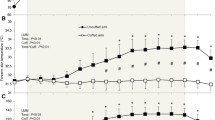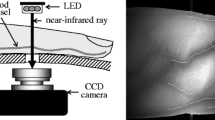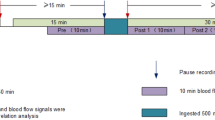Summary
The present study was performed to investigate the effect of food intake on thermoregulatory vasodilatation in seven healthy male volunteers. The changes in oesophageal (T oes) and mean skin temperatures, finger and forearm blood flows (BF), oxygen consumption (VO2) and heart rate (f c) with and without food intake were measured before and during a 40-min exercise at an intensity of 35% maximal O2 consumption at an ambient temperature of 25°C. Exercise commenced 60 min after food intake. Ingestion of food equivalent to 50.2 kJ · kg body mass−1 elevated mean body temperature, BF,VO2 andf c in 60 min. Four subjects responded to exercise with a marked increase in finger BF and with no sweating (non-sweating group), while the other three responded with perspiration over almost the whole skin area and with little change in finger BF. Further analyses were made mainly in the non-sweating group. The postprandial increases inT oes, BF,VO2 andf c were persistent during exercise. The rate of increase in finger BF with the increase inT oes and mean body temperature was significantly greater with food intake than without. However, there was no difference in the response of forearm BF to exercise between the two conditions. These results suggested that food intake enhanced finger BF response to the increase in deep body temperature during exercise. It was also concluded that there was a regional difference in cutaneous vasomotor response to thermal load in the post-prandial subjects.
Similar content being viewed by others
References
Fronek K, Stahlgren LH (1968) Systemic and regional hemodynamic changes during food intake and digestion in nonanesthetized dogs. Circ Res 23:687–692
Hales JRS, Fawcett AA, Bennett JW, Needham AD (1978) Thermal control of blood flow through capillaries and arteriovenous anastomoses in skin of sheep. Pflügers Arch 378:55–63
Hirai A, Hirata K, Hirashita M, Takahata T (1989) Effect of food intake on skin temperatures and thermal sensation (in Japanese). Hokuriku Taiikugakkai Kiyo 25:25–29
Hirata K, Nagasaka T, Hirai A, Hirashita M, Takahata T (1983) Peripheral vascular tone during heat load is modified by exercise intensity. Eur J Appl Physiol 51:7–15
Hirata K, Nagasaka T, Hirai A, Hirashita M, Takahata T (1986) Effects of human menstrual cycle on thermoregulatory vasodilation during exercise. Eur J Appl Physiol 54:559–565
Hirata K, Nagasaka T, Noda Y (1989a) Venous return from distal regions affects heat loss from the arms and legs during exercise-induced thermal loads. Eur J Appl Physiol 58:865–872
Hirata K, Nagasaka T, Hirashita M, Takahata T (1989b) Increase in evaporative and non-evaporative heat loss from the forearm depends on venous return from the hand during exercise. In: Mercer JB (ed) Thermal Physiology 1989, International Congress series 871 Excerpta Medica, Elsevier, Amsterdam, pp 155–159
Honda N (1962) Temperature compensation for mercury strain gauge used in plethysmography. J Appl Physiol 17:572–574
Johnson JM, Rowell LB, Brengelmann GL (1974) Modification of the skin blood flow-body temperature relationship by upright exercise. J Appl Physiol 37:880–886
Jones WB, Thomas HD, Reeves TJ (1965) Circulatory and ventilatory responses to postprandial exercise. Am Heart J 69:668–676
Kelbæk H, Munck O, Christensen NJ, Godtfredsen J (1987) Autonomic nervous control of postprandial hemodynamic changes at rest and upright exercise. J Appl Physiol 63:1862–1865
LeBlanc J, Brondel L (1985) Role of palatability on meal-induced thermogenesis in human subjects. Am J Physiol 246:E333-E336
LeBlanc J, Cabanac M, Samson P (1984) Reduced postprandial heat production with gavage as compared with meal feeding in human subjects. Am J Physiol 246:E95-E101
Mashford ML, Nilsson G, Rokaeus A, Rosell S (1978) The effect of food ingestion on circulating neurotensin-like immunoreactivity (NTLI) in the human. Acta Physiol Scand 104:244–246
Morley JE, Levine AS, Gosnell BA, Mitchell JE, Krahn DD, Nizielski SE (1985) Peptides and feeding. Peptides 6:181–192
Nadel ER (1980) Circulatory and thermal regulations during exercise. Fed Proc 39:1491–1497
Nadel ER, Pandolf KB, Roberts MF, Stolwijk JAJ (1974) Mechanisms of thermal acclimation to exercise and heat. J App] Physiol 37:515–520
Nagasaka T, Shido O (1989) Locomotor activity and heat production of rats on restricted two-hour feeding regimes. Jpn J Biometeorol 26:85–90
Nelms JD (1963) Functional anatomy of skin related to temperature regulation. Fed Proc 22:933–936
Nichols J, Ross S, Patterson P (1988) Thermic effect of food at rest and following swim exercise in trained college men and women. Ann Nutr Metab 32:215–219
Nielsen B (1987) Does diet-induced thermogenesis change the preferred ambient temperature of humans? Eur J Appl Physiol 56:474–478
Segal KR, Gutin B, Albu J, Pi-Sunyer FX (1987) Thermic effects of food and exercise in lean and obese men of similar lean body mass. Am J Physiol 252:E110-E117
Sherman JL (1963) Normal arteriovenous anastomoses. Medicine (Baltimore) 42:247–267
Shido O, Nagasaka T (1985) Effects of intraventricular neurotensin on blood pressure and heat balance in rats. Jpn J Physiol 35:311–320
Shido O, Yoneda Y, Nagasaka T (1989) Changes in brown adipose tissue metabolism following intraventricular vasoactive intestinal peptide and other gastrointestinal peptides in rats. Jpn J Physiol 39:359–369
Steffens AB, Gugten JVD, Godeke J, Luiten PGM, Strubbe JH (1986) Meal-induced increases in parasympathetic and sympathetic activity elicit simultaneous rises in plasma insulin and free fatty acids. Physiol Behav 37:119–122
Stephenson LA, Wenger CB, O'Donovan BH, Nadel ER (1984) Circadian rhythm in sweating and cutaneous blood flow. Am J Physiol 246:R321-R324
Takano N, Kotani M (1989) Influence of food intake on cold-induced vasodilation of finger. Jpn J Physiol 39:755–765
Welle SL (1984) Metabolic responses to a meal during rest and low-intensity exercise. Am J Clin Nutr 40:990–994
Welle SL, Lilavivathana U, Campbell RG (1980) Increased plasma norepinephrine concentrations and metabolic rates following glucose ingestion in man. Metabolism 29:806–809
Welle SL, Lilavivathana U, Campbell RG (1981) Thermic effect of feeding in man. Metabolism 30:953–960
Whitney RJ (1953) The measurement of volume changes in human limbs. J Physiol 121:1–27
Woods SC, West DB, Stein LJ, Mckay LD, Lotter EC, Porte SG, Kenney NJ, Porte D Jr (1981) Peptides and the control of meal size. Diabetologia 20:305–313
Author information
Authors and Affiliations
Rights and permissions
About this article
Cite this article
Hirai, A., Tanabe, M. & Shido, O. Enhancement of finger blood flow response of postprandial human subjects to the increase in body temperature during exercise. Europ. J. Appl. Physiol. 62, 221–227 (1991). https://doi.org/10.1007/BF00643746
Accepted:
Issue Date:
DOI: https://doi.org/10.1007/BF00643746




